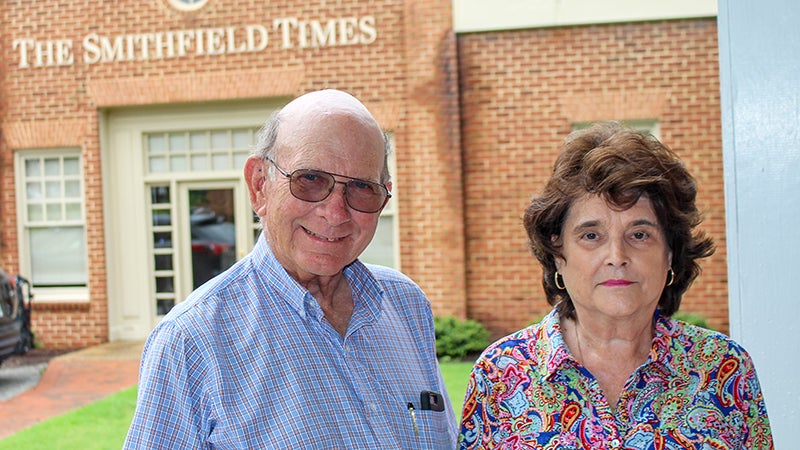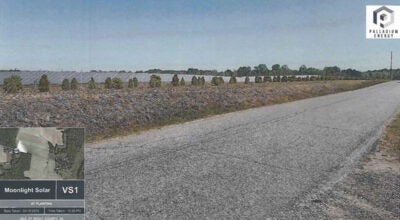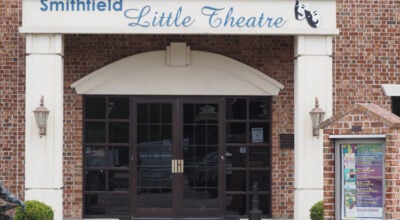The first draft of history
Published 6:32 pm Tuesday, September 29, 2020

- John and Anne Edwards ran The Smithfield Times for more than 30 years.
For 47 years, John Edwards helped write the first draft of history for Smithfield.
As the Smithfield Times celebrates its 100th anniversary in 2020, Edwards and his wife, Anne, are so far tied for being the longest tenured owners of the newspaper. John joined the paper in 1972 and in 1986, he and Anne bought it.
A group of local businessmen established The Smithfield Times in 1920. In its first decade, the paper operated under several owners and managers. In 1930, Jesse Scott and his wife, Lillian, purchased the newspaper and ran it until 1962, when they sold it to Tom and Betty Phillips. John and Anne, who are both Isle of Wight County natives, returned to Smithfield in 1972 after John left the Navy. The Phillipses hired John as managing editor and reporter. The Edwardses, in turn, bought the paper from the Phillipses in 1986.
Jesse and Lillian Scott ran the paper for 33 years. Tom and Betty Phillips ran the paper for 23 years. John and Anne, the paper’s longtime business manager, retired in late 2019. They sold the business to now-publisher Steve Stewart, bringing the paper under the umbrella of Boone Newspapers Inc.
In a recent interview at the Smithfield Times’ office, they acknowledged it’s been a big change to step away from their passion and work, which they did for decades.
“It’s been hard,” said Anne. “I can tell you that. It’s been hard. It’s just a different lifestyle.” John agreed.
“I think COVID probably made retirement a little more difficult than it would have been,” he said. “We were planning to do some traveling. Our traveling now is to the drugstore and the grocery store. That’s about it. I think that probably made the transition a little duller than it would have been.”
John, who has continued to write his popular “In the Short Rows” column, also said he missed being in touch with breaking and developing news. Before retiring, “I was right on top of everything for a very long time. And now I don’t know what’s going on.”
Having started in 1972, John is likely one of the newspaper’s longest serving employees. “I carried the title of managing editor but I was the janitor and the reporter and the darkroom and everything else,” he said.
Anne joined him at work in 1986 when they bought the paper. Before that, she was director and teacher of preschool at Benn’s United Methodist Church. Along the way, they raised three kids. “And she largely raised them because I was here 60, 70 hours a week,” John said.
“I always came to work at 6 o’clock in the morning on Tuesday for 40 years,” John continued. “I’d usually take a break for breakfast at some point, but I’d go to work at 6 and back in the ’70s, we could be here until 8 or 9 o’clock at night, putting a 12-page paper together.”
Today, newspaper production is mostly electronic, done with computers and digital files. But back in the 1970s, it was hands-on work. “We pasted up the pages in the back,” Anne said. John recalled the process.
“I was doing stories on canary sheets on a typewriter when I came here — reams of cheap yellow paper called canary sheets, and that’s what was used for copy paper in newsrooms all over the world,” he said.
To write a story, “you’d keep a paste pot of rubber cement and paste your pages together in order so they didn’t get scrambled up so that whoever was typesetting them they could roll it over and double space everything and edit with a big bold pencil, a copy pencil.
The paste up production process continued for about a year when they bought Macintosh Plus computers. “I would say by ’87 or ’88, we had bought the first Mac Pluses, the little square computers, a self-contained computer.”
Although the production process evolved, the paper’s atmosphere — a family business — didn’t change.
Anne decided to leave her career to support the business. “We bought the paper, and we didn’t have any money, and it was better for me to come and do the accounting than to pay somebody else to do it. That’s how I started working at the paper.” She went on to run the paper’s business operations.
“It was our life. Our kids, our baby particularly, took her naps and everything else in our office,” she said. “My office always had a little daycare in it,” she said. “Children and grandchildren have all grown up here.”
From tediously placed hand-set type, to linotype machines, and now to pixels on smartphone screens displayed through social media, the presentation of news has evolved through various mediums and processes, and it must continue to do so, John said. The future of newspapers “has almost got to go electronic,” John said. “Nobody has come up with a formula that replaces advertising as a major revenue source for newspapers. Subscribers help — (but) they don’t pay the bills,” he said.
Sometimes, changes are pursued for style. On the recommendation of a media expert from Richmond, and with the blessing of former owner and publisher Phillips, the paper changed its name and was known simply as “The Times” for a brief period in the 1980s.
“Sure enough, circulation increased fairly sharply in Zuni, Ivor and out in Surry, so it was a resounding success,” John said. But one day, a letter from a lawyer, acting on behalf of The Times of London, arrived in the mail. The letter alleged trademark infringement.
The conflict with the London newspaper became national and international news. Although they can laugh about it now, “It wasn’t funny at the time,” Anne said. The Hampton Roads law firm that failed to check for the possibility that “The Times” name was already internationally trademarked “did have the good grace to do all the work for free to change (the name) back,” and secure “The Smithfield Times” trademark, John said.
Over a nearly 50-year career in writing and editing local news, John said the environment was a topic he always felt deeply passionate about covering. Feature stories on local people and places are great, too, but he said he also found deep fulfillment in hard news. Sometimes telling people what they need to know instead of what they want to hear doesn’t sit well, especially in a small town.
“It is more difficult,” he said. “Somebody stays mad with you all the time. You either get a thick skin or you don’t do it, because somebody’s going to stay mad with you.” But both said they felt a responsibility to show and tell people what’s really going on.
“You just have to do it with integrity,” he said. “People may be mad with you, but as long as they know you’re doing an honest job, they’ll tolerate it,” John said. “You’ve just simply got to call it like it happens. It’s just going to be unpopular at times, but people are pretty tolerant actually, and I think we’ve enjoyed pretty broad support.”
In an era when shouts of “fake news” ring out when people see or hear a story they don’t like, don’t agree with or simply don’t understand, John said local newspapers are more important than ever.
To rebuild and keep the trust of the community, newspapers must put “all our effort toward accuracy and fairness, and that’s what we hope they’ll focus on. I think people still respect that, and I think they expect that.”





